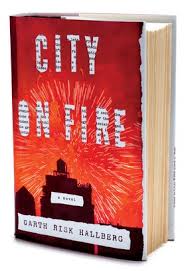
Guest contributor: Bill Lundgren
Lundgren’s Lounge: “City on Fire,” by Garth Risk Hallberg
categories: Cocktail Hour / Reading Under the Influence
Comments Off on Lundgren’s Lounge: “City on Fire,” by Garth Risk Hallberg

During the 3 or 4 days that I was immersed in this novel it was like an appendage, a siren that summoned me from the depths of sleep at 3 a.m: ‘Oh, yes, the book.’ And reach over to turn on the reading light, dive back into the tumultuous world of New York City during a few months in 1976-1977.
By the time I was living and studying and teaching in NYC, during the nineties, much of the city had been thoroughly scrubbed and sanitized by Guliani and his minions until it gleamed. Times Square had been Disneyfied and one of my neighborhoods on the upper West Side felt distinctly like a gated community. What a contrast with the New York of City on Fire. Hallberg, who intriguingly is too young to have actually lived it, describes a time of fire and foment and the meteoric rise of punk culture. Gerald Ford’s famous response to the city’s plea for bailout money during this time was, “Drop Dead,” as this most iconic of American megalopolises teetered on the brink of both insolvency and total anarchy. The subway was to be avoided and the notion of entering Central Park after dark was considered sheer lunacy. Yet amongst the lawlessness and the sense of things abjectly out of control there was a parallel mood of wild, unfettered, limitless possibil  ity–after all, if everything was falling apart, why worry about consequences?
ity–after all, if everything was falling apart, why worry about consequences?
The strands of the narrative are woven mostly by the young or youngish; there is Sam and Charlie, two suburba n Long Islanders drawn to the downtown punk scene, she a young beauty with an artist’s eye and an enthusiastic fanzine and Charlie, her gawky, endearing lovestruck sidekick who is up for anything. Then there are the sister and brother, Regan and William Hamilton-Sweeney, estranged heirs to one of the city’s great fortunes and their respective partners, Regan’s husband Keith, seduced into the Sweeney business empire and, Mercer, a transplanted Southern black m an lured to the city to teach, who falls in love with William. Add a cynical reporter, a jaded detective trying to hold on to the last vestiges of idealism and a shooting on New Year’s Eve in Central Park and you have all the ingredients for 900 pages of mesmerizing fiction.
Oh and lest I forget, there is anarchist punk rock band collective that aspires, with one dramatic act, to remind New Yorkers of the precariousness of existence, a flamboyantly eccentric art dealer and Sam’s father, one of the last of the firework artistes, as they are being slowly and inexorably replaced by digital technology.
At the heart of Hallberg’s accomplishment here is how deeply he makes us care about the city and its denizens without ever resorting to sentimentality. When I read that one of the novel’s main characters had died, my grief was profound and visceral and when I discovered that the character had, after all, somehow miraculously survived, the rush of relief was just as genuine. On reflection I realized that these emotions were dual-faceted: on one hand I became inordinately fond of the characters and on the other, I am stupefied and bedazzled that the author could foster such readerly affection for a fictional creation.
The morning after a late night spent devouring the final pages of City on Fire, my wife asked me, “So, ready to return to the land of the living?” And that’s sort of the point: these people and this story are and always will be alive for me. Having been introduced, I feel stronger and better equipped to survive in the land of the living.
And if anyone tries to tell you that the novel is dead, simply point them towards City of Fire.

[Bill Lundgren is a writer and blogger, also a friend of Longfellow Books in Portland, Maine (“A Fiercely Independent Community Bookstore”), where you can buy this book and about a million others, from booksellers who care. Bill keeps a bird named Ruby, a blind pug named Pearl, and a couple of fine bird dogs, and teaches at Southern Maine Community College. ]
